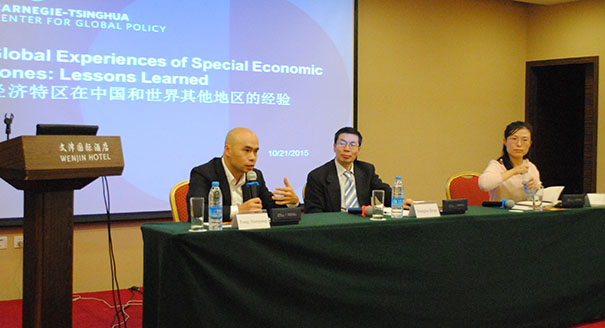Registration
You will receive an email confirming your registration.
Since the 1970s, special economic zones (SEZs) have proliferated rapidly in China and around the world. The economic growth generated by SEZs has been a major component of China's progress since the “opening and reform” period, and developing nations are increasingly interested in emulating China’s SEZ success.
Carnegie–Tsinghua’s Tang Xiaoyang hosted a conversation with Douglas Zeng and Xu Jiajun about the patterns observed from thirty years of data on SEZs around the world. They examined common characteristics of successful SEZs, strategies for how to capture economic benefits for local economies, and lessons that other developing countries can glean from China’s experience.
Discussion Highlights
- Common Features: Participants highlighted several common features that successful SEZs share:
- Government Support: Strong, consistent, and long-term support from the highest levels of government provides the SEZs with the tools to enact new programs and furnish a less regulated space for businesses to flourish.
- Institutional Support: Panelists asserted that institutional systems—such as effective legal frameworks, well-crafted performance incentives, and competent organizations to oversee development—play a crucial role.
- Location and Physical Infrastructure: Such institutional systems and government support reinforces critical physical features such as a strategic geographical location and sufficient transportation and energy infrastructure to meet the needs of local populations.
- Benefits of Successful SEZs: Panelists noted several of the well-documented direct benefits that SEZs can produce, such as boosting employment, increasing foreign exchange earnings and foreign direct investment, and driving export growth. For countries that primarily export raw materials, SEZs can also help their economies diversify by opening opportunities for new industries. Participants also pointed out that if these economic zones are carefully managed and integrate local businesses, they can give rise to secondary advantages such as upgrading workers’ skills, facilitating technology transfers, and promoting modern management practices. Moreover, as China’s development experience demonstrates, SEZs can serve as testing grounds for economic reforms or policy experimentation.
- SEZs Around the World: Panelists compared economic conditions and SEZ performance in different geographical regions, with a focus on Asia where there are nearly 500 national-level SEZs. China’s achievements have been particularly noteworthy, as the country’s SEZs have directly created more than 30 million jobs since the reform era began. They also highlighted Malaysia’s Penang Free Trade Zone for its role in lowering the state’s poverty rate from 30.2 percent in 1972 to 0.3 percent in 2010. South Korea’s Masan Free Trade Zone was another positive example, generating 13 to 15 percent of the country’s value-added production despite accounting for only 0.2 percent of the country’s land zoned for industrial activities.
- Challenges Posed by SEZs: Speakers acknowledged that SEZs are not a panacea for development and that many have been largely unsuccessful. They suggested that limited infrastructure, political instability, and an absence of enforceable legal frameworks may account for the scarce progress that many African SEZs have made. In addition, panelists cautioned against developing too many SEZs too quickly, which can unleash production capacities far in excess of demand, as occurred in China in the early 2000s. China’s struggles with environmental degradation were also cited as a cautionary tale for other developing nations.
- Emerging Models: The future of successful SEZs relies on private-public partnerships, speakers asserted. These joint initiatives can help persuade risk-averse financial institutions to invest in small- and medium-sized enterprises, emboldened by government partners that have a greater capacity to recover from failed ventures. Panelists also noted that major financial institutions, such as the World Bank, are gradually becoming more accepting of SEZs and beginning to allocate funds and implement programs to support SEZs and their empirically documented value to developing countries.
Douglas Zeng
Douglas Zeng is a senior economist at the World Bank and a global expert on macroeconomic policy, innovation, SEZs, economic clusters, competitiveness, and knowledge-based economies. He previously worked as a scholar at the Chinese Academy of Social Sciences and at Stanford University.
Tang Xiaoyang
Tang Xiaoyang is a resident scholar at the Carnegie–Tsinghua Center for Global Policy and an associate professor in the Department of International Relations at Tsinghua University. His research interests include political philosophy, China’s modernization process, and China’s engagement in Africa.
Xu Jiajun
Xu Jiajun is an assistant professor in the National School of Development and executive deputy director of the Center for New Structural Economics at Peking University. Her research interests include development financing, international financial institutions, and international political economy.
